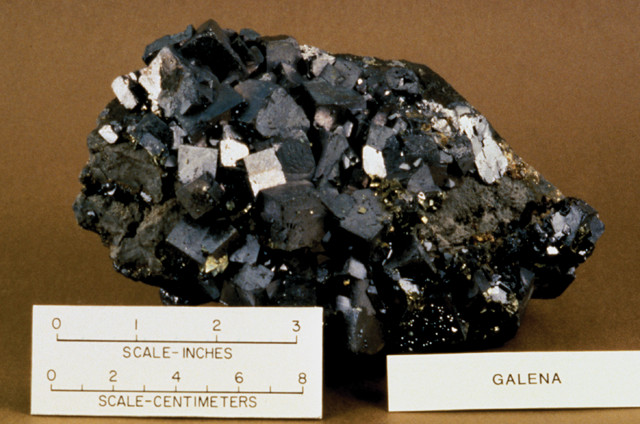
by U.S. Geological Survey Thursday, June 14, 2018
David E. Guberman, a mineral commodity specialist for the U.S. Geological Survey, compiled the following information on lead, a metal used in everything from alloys and ammunition to batteries and radiation shielding.

Galena is the most important lead mineral. Credit: ©U.S. Geological Survey/ESW Image Bank
Lead is a corrosion-resistant, dense, ductile and malleable blue-gray metal that has been used by humans for more than 5,000 years. Humans first used it in decorative fixtures, roofs, pipes and windows. Today, its primary use is in lead-acid batteries.
Lead is the fifth-most-consumed metal, by tonnage, after iron, aluminum, copper and zinc. Occurrences of concentrated and easily accessible lead ore deposits are widely distributed throughout the world. About 240 mines in more than 40 countries produce lead concentrates. The most important ore mineral is galena, followed by anglesite and cerussite. Lead and zinc minerals often occur in the same deposits, and the two are frequently mined together and then separated. Refined lead is produced in nearly 250 primary and secondary plants in more than 55 countries; in the U.S., it comes mostly from recycled lead-acid batteries.
The proportion of refined lead originating from secondary sources has increased significantly during the past two decades owing to the high rate of lead-acid battery recycling. The recycling rate for lead-acid batteries in North America is 96 percent — greater than other commonly recycled consumer goods such as paper (73 percent), aluminum cans (54 percent), tires (50 percent) and glass bottles (25 percent). Most of the recovered lead is used to make new batteries and can be recycled indefinitely.
Today, more than 80 percent of lead is used to make lead-acid batteries. Historically, it also has been used in a multitude of other applications such as ammunition and shot, cathode ray tubes, fishing weights, fuel additives, pigments in paints, pipes, and solder and wheel weights. But concerns about the potential harmful effects to the environment and people have curtailed or completely eliminated lead from many of these applications.
Today, lead is the primary ingredient used to manufacture the starting, lighting and ignition (SLI) automotive battery, an integral component in nearly every gasoline-powered vehicle on the road worldwide. A typical SLI battery used in a passenger car contains about 10 kilograms of lead and needs to be replaced every four to five years. Lead-acid batteries are also used in industrial applications such as standby power for computer networks and telecommunications systems, and for motive power in vehicles like forklifts. Emerging uses for lead-acid batteries that could become more prevalent in the future include storage batteries for renewable energy and in certain types of hybrid-electric vehicles.
For more information on lead and other mineral resources, visit http://minerals.usgs.gov/minerals.
World mine production of lead was 3.84 million metric tons in 2008. Four countries — China, Australia, the United States and Peru — produce 76 percent of the world’s lead.
World production of refined lead (primary and secondary) was 8.62 million metric tons in 2008.
World consumption of refined lead was 8.65 million metric tons in 2008.
“Plumbing” is derived from the Latin word “plumbum,” meaning lead. Lead was historically used in piping.
During the Middle Ages, lead was a key component in processes used by alchemists who claimed to produce gold from base metals.
The first movable type used to print the Gutenberg Bible was made from an alloy of lead, tin and antimony.
Lead-acid batteries keep more than cars rolling. An estimated 100 million electric bicycles, known as e-bikes, are currently on the roads in China, powered by a small lead-acid battery that lasts for about a year.
Lead has never been used in pencils; “pencil lead” is actually graphite, which is made of carbon.
Lead’s protective qualities are still unrivaled when it comes to shielding people from potentially harmful radiation, such as X-rays.
© 2008-2021. All rights reserved. Any copying, redistribution or retransmission of any of the contents of this service without the expressed written permission of the American Geosciences Institute is expressly prohibited. Click here for all copyright requests.